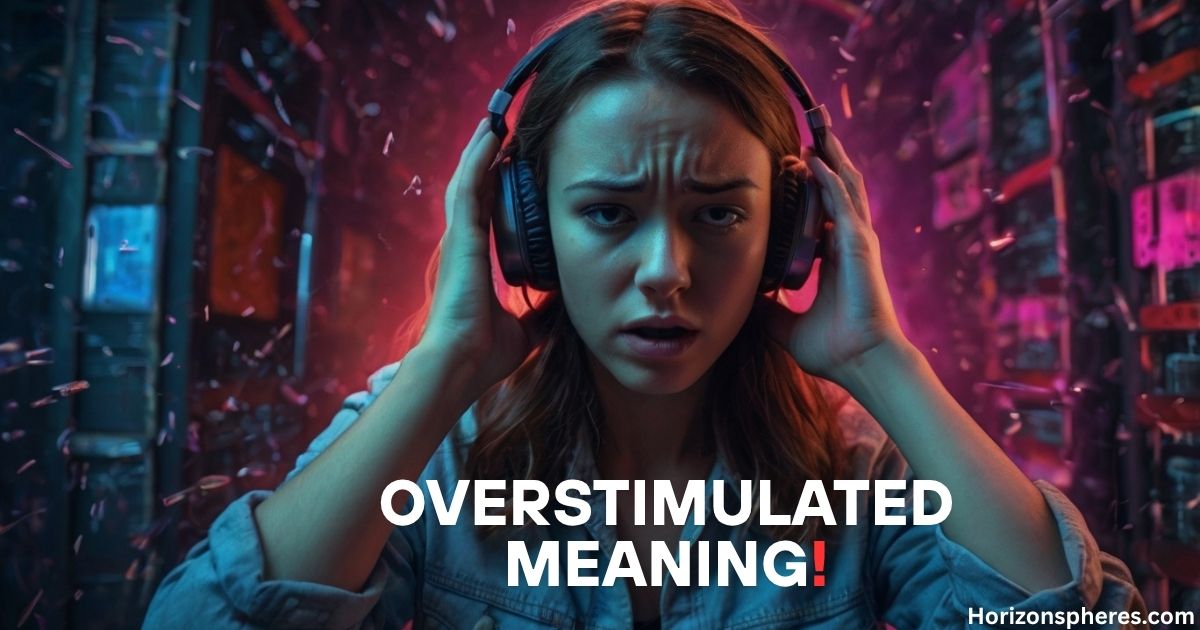Your phone buzzes constantly. Traffic noise overwhelms your senses. Bright office lights make you squint while colleagues chat loudly nearby. Sound familiar? Overstimulation is when the brain gets too much input at once.
This can make it hard to focus, think clearly, or stay calm. Feeling annoyed or drained, acting confused or frustrated, and not being able to make decisions could be signs of overstimulation in adults. Being overstimulated is unpleasant, to say the least.
What Does “Overstimulated” Mean?

Overstimulated meaning refers to a state where your nervous system receives more sensory information than it can effectively process. Think of your brain as a computer processor – when too many programs run simultaneously, it slows down or crashes.
The Brain’s Processing System
Your brain constantly filters millions of sensory inputs every second. Neurologically, overstimulation occurs when this filtering system becomes overwhelmed. The prefrontal cortex, responsible for executive function, struggles to prioritize information effectively.
Different Cultural Perspectives
- Overstimulated meaning in Spanish: “sobreestimulado” describes excessive sensory bombardment
- Overstimulated meaning in French: “surstimulé” refers to overwhelming sensory input beyond normal capacity
Causes of Overstimulation
Modern life bombards us with constant sensory input. Digital devices, urban environments, and workplace pressures create perfect storms for sensory overload. Understanding these triggers helps you identify your personal vulnerability patterns.
More Post: SYBAU Meaning Exposed: The Viral Slang That’s Dividing the Internet in 2025
Environmental Triggers
| Trigger Type | Examples | Impact Level |
| Visual | Bright lights, screens, clutter | High |
| Auditory | Traffic, conversations, music | Very High |
| Tactile | Rough textures, temperature changes | Medium |
| Olfactory | Strong perfumes, food smells | Medium |
Digital Overload Factors
Screen time averages 7+ hours daily for American adults. Blue light exposure disrupts circadian rhythms while constant notifications fragment attention spans. Social media platforms deliberately overstimulate users through rapid content switching.
Workplace Stressors
Open office designs increase sensory bombardment by 300% compared to private spaces. Multitasking demands force brains to rapidly switch between tasks, creating cognitive exhaustion.
Symptoms of Overstimulation
Over stimulated meaning in adults manifests through various physical, emotional, and behavioral changes. Recognizing these warning signs enables early intervention before symptoms escalate into chronic stress patterns.
Physical Warning Signs
Your body sends clear distress signals when overwhelmed. Headaches often strike first, followed by muscle tension in shoulders and neck. Digestive issues like nausea or stomach upset frequently accompany sensory overload episodes.
Emotional Indicators
Irritability spikes dramatically during overstimulation. You might snap at loved ones or feel unreasonably frustrated by minor inconveniences. Anxiety levels increase while emotional regulation becomes challenging.
Behavioral Changes
Social withdrawal becomes attractive when overstimulated. You might cancel plans, avoid crowded spaces, or seek quiet environments. Decision-making feels impossible as your brain struggles to process competing inputs.
Managing Overstimulation
Effective overstimulation management requires both immediate relief strategies and long-term lifestyle modifications. Psychology research shows that consistent practice of coping techniques builds resilience against future sensory overwhelm episodes.
More Post: Huzz Meaning: Understanding the Term and Its Alternatives in Everyday Language
Immediate Relief Techniques
The 5-4-3-2-1 grounding method provides instant sensory reset:
- 5 things you can see
- 4 things you can touch
- 3 things you can hear
- 2 things you can smell
- 1 thing you can taste
Environmental Modifications
| Area | Quick Fixes | Long-term Solutions |
| Lighting | Dim harsh lights | Install soft LED bulbs |
| Sound | Use noise-canceling headphones | Add sound-absorbing materials |
| Organization | Clear visible clutter | Create designated spaces |
Digital Wellness Strategies
Screen breaks every 20 minutes prevent digital fatigue. Notification management reduces interruption frequency. Create phone-free zones in bedrooms and dining areas.
Special Considerations

Overstimulated Child Meaning
Children’s developing nervous systems process sensory information differently than adults. Overstimulated meaning child includes meltdowns, hyperactivity, or sudden withdrawal. Sensory breaks help kids reset their systems.
Overstimulated Baby Meaning
Infants show overstimulation through crying, arching backs, or turning away from stimuli. Quiet environments and gentle movement often provide relief.
Relationship Impact
Overstimulated meaning in a relationship affects communication and intimacy. Partners may misinterpret withdrawal as rejection. Open communication about sensory needs prevents misunderstandings.
Intimate Situations
Overstimulation meaning in bed can affect physical intimacy. Sensory sensitivity may require environmental adjustments like softer lighting or reduced background noise.
Professional Support
Occupational therapists specialize in sensory processing issues. Psychologists help develop coping strategies while neurologists rule out underlying medical conditions.
Frequently Asked Questions
What does it mean to be overstimulated?
Being overstimulated means your brain receives more sensory input than it can effectively process, causing overwhelm and discomfort.
What happens when a girl is overstimulated?
Girls may experience irritability, anxiety, withdrawal, difficulty concentrating, and physical symptoms like headaches when overstimulation occurs.
Is overwhelmed and overstimulated the same?
While similar, overwhelmed typically refers to emotional stress, whereas overstimulated specifically involves excessive sensory input processing difficulties.
What is a word for feeling overstimulated?
Common synonyms include overwhelmed, overloaded, saturated, bombarded, inundated, swamped, flooded, or experiencing sensory overload situations.
Conclusion
Understanding overstimulated meaning empowers you to recognize sensory overload patterns and implement effective management strategies. From identifying personal triggers to creating calming environments, small changes yield significant improvements.
Remember, managing overstimulation isn’t about eliminating all stimuli—it’s about finding your optimal sensory balance for enhanced well-being and productivity in our increasingly connected world.










